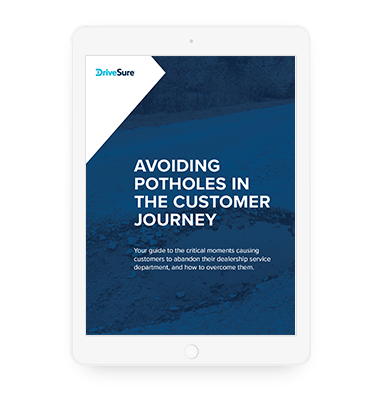Sometimes, small process changes can help your dealership improve profitability in multiple ways at once. When you improve your service lane interactions for instance, you can improve both productivity and customer loyalty.
In our Dealership Service Retention Report, we found that quality of work is the #1 factor driving customers back to dealerships — and one of the main factors driving them away when it’s overlooked.
So what does it take to deliver the quality customers want? Let’s explore:
Prepare for the 5 make-or-break moments that can cause service customers to start going elsewhere.
Improving repair quality and speed with better repair orders
When it comes to quality work in the service department, a good maintenance or repair job starts with a good process for filling out a repair order properly.
By taking steps to ensure a quality repair from the first interaction with a customer, you can improve turnaround time, and get the repair right the first time. That requires getting the right process down for your repair order (also called a service ticket or job card).
With faster turnarounds and better repairs (where the customer doesn’t have to return to the service lane for the same problem), you get greater customer satisfaction, more repeat customers, and can expand the capacity of your service lane with more jobs per day.
So how can you go about this?
You can start by asking the right questions when the customer arrives, to make sure your diagnosis is accurate. Bear in mind that many drivers don’t have the mechanical knowhow to describe these problems well, so ask questions based on what they’ve observed:
- “What’s happening?” — Start by figuring out what brought them to you in the first place. Ask follow-up questions to get more specific. If they say there’s smoke coming out of the car, ask them where it’s coming from and what color the smoke is. If the car is making a sound, you’ll ask them to describe the sound. There are dozens of noises to consider, and a clunking noise may be a very different issue than a whirring or hissing noise.
- “When does it happen?” — Some customers may not even know the difference between an engine and a transmission, but they can probably tell you what they were doing when they noticed the problem, such as whether it was when starting the car, braking, accelerating, etc.
- “How often does it happen?” — Is the issue happening every time they do something, constantly, or maybe just sometimes?
Make sure the diagnosis quality is consistent
Rather than relying on each employee to remember all the questions they should ask, it often makes more sense to have them work through a checklist with the items listed above, and any follow-up questions.
Getting this right from the beginning is important because a misdiagnosed problem can easily be hundreds of dollars more expensive than the customer expects.
From the research we’ve done with vehicle owners, we’ve found a single bad experience at the dealership puts it at risk for losing any customer, regardless of their loyalty. If you can’t manage expectations effectively, you risk losing their trust, and they can easily go elsewhere.
When you can consistently give an accurate estimate though, you can avoid unpleasant surprises.
Don’t reinvent the wheel for repairs — the problem may have been solved already
Before a repair diagnosis begins, you can save time by checking to see if the problem is already listed in a database of technical service bulletins (TSBs) from the manufacturer. Oftentimes the problem has already been figured out, so all you have to do is follow the TSB guide to make the fix, instead of going through a lengthy diagnosis process.
Oftentimes, TSBs will also outline any special tools or training that might be necessary for the job at hand — both of which could save time and effort during diagnosis and repair.
Improve service advisor training and processes
High-quality service extends beyond skilled technicians: a great service advisor can be a game-changer for your service lane. A service advisor should have a deep understanding of your dealership’s processes, and should be able to effectively communicate with both technicians and customers.
To do this well, they need a solid understanding of the (sometimes complex) service recommendations they handle, so they can clearly communicate this in layman’s terms to the customer. They’ll also need to adapt their language based on the technical knowledge of each customer, and their communication methods based on the customer’s age. People skills are an important factor in this role, as service advisors will frequently interact with vendors, suppliers, and upset customers.
For instance, you may introduce a system to record sales calls and get feedback from those customers. This provides a clear way to service advisors to actively improve.
Inefficient processes can also hold your whole team back. You may need to improve service department efficiency, such as by better scheduling methods, leveraging technology, and updating your department’s organizational skills.
Ensure adequate inspections to catch issues before customers do
A thorough inspection process will help you catch new problems, rather than merely addressing the problem the customer came in for. By catching these problems early and upselling effectively, you build more trust with customers.
For instance, if the customer comes in for an electrical issue and you notice a different issue elsewhere that will get worse if left unaddressed, you can and should offer to preemptively fix it. This can not only save the customer money on an expensive repair, but it also gives them control over when they get the issues fixed (rather than waiting for their car to stop working properly).
Similarly, a customer may be a few months shy of a tire change, but you notice the tire might need changed sooner than that. This gives you an opportunity to promote your tire repair and replacement capabilities, which in turn helps boost retention.
This is well-known to service managers today, but it’s worth focusing on with your team. As service centers have gotten busier, it’s all too easy for a technician to hurry through an inspection or focus only on the issue at hand.
Use service visits to provide value-added benefits
While a high-quality repair can keep customers coming back, and great customer service will help, sometimes you need to offer more incentive.
For example, our DriveSure programs provides a unique set of renewable benefits with qualifying service visit that’s designed to easily bring customers back for tires, service, and unplanned repairs—all while avoiding unprofitable discounts or loyalty programs.
This extra value sets you apart from competitors in the mind of your customers, building stronger relationships and giving you the means to stay top of mind.
Master These Moments to Keep Your Customers
Discover the 5 critical moments causing customers to abandon your dealership service department, and how you can overcome them.


